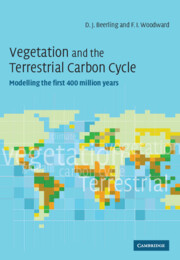Book contents
- Frontmatter
- Contents
- Preface
- Acknowledgements
- 1 Introduction
- 2 Investigating the past from the present
- 3 Climate and terrestrial vegetation
- 4 Climate and terrestrial vegetation of the present
- 5 The late Carboniferous
- 6 The Jurassic
- 7 The Cretaceous
- 8 The Eocene
- 9 The Quaternary
- 10 Climate and terrestrial vegetation in the future
- 11 Endview
- References
- Index
5 - The late Carboniferous
Published online by Cambridge University Press: 09 August 2009
- Frontmatter
- Contents
- Preface
- Acknowledgements
- 1 Introduction
- 2 Investigating the past from the present
- 3 Climate and terrestrial vegetation
- 4 Climate and terrestrial vegetation of the present
- 5 The late Carboniferous
- 6 The Jurassic
- 7 The Cretaceous
- 8 The Eocene
- 9 The Quaternary
- 10 Climate and terrestrial vegetation in the future
- 11 Endview
- References
- Index
Summary
Introduction
One of the fundamental aims of interpreting and analysing the fossil record of land plants is to understand the patterns and processes underlying their evolution. This may best be achieved through palaeobotanical interpretations of the plant fossil record, and through modelling. This book is primarily concerned with the use of core physiological models, based on a knowledge of present-day processes, to address the impacts of past atmospheres and climates on plant function. The approach is offered as complementary to analyses of the fossil record of plant life itself. In some cases a modelling approach can be achieved rather simply, at least at the scale of individual leaves (Beerling, 1994; Beerling & Woodward, 1997), by considering the mathematical relationships between leaf CO2 assimilation and the stoichiometry of the biochemistry of leaf photosynthesis (Farquhar et al., 1980; von Caemmerer & Farquhar, 1981) and the composition of ancient atmospheres. In other cases, features characteristic of the Carboniferous period, such as the role played by fire in shaping the development of terrestrial ecosystems (Cope & Chaloner, 1980; Chaloner, 1989; Robinson, 1989; Jones & Chaloner, 1991; Scott & Jones, 1994) are important to consider but more difficult to represent.
The Berner & Canfield (1989) geochemical model of atmospheric O2 variations predicts that the highest O2 values (35%) over the past 570 million years probably occurred in the Carboniferous – compared with the present atmospheric level (PAL) of 21%.
- Type
- Chapter
- Information
- Vegetation and the Terrestrial Carbon CycleThe First 400 Million Years, pp. 100 - 134Publisher: Cambridge University PressPrint publication year: 2001



